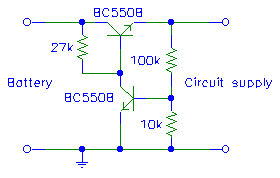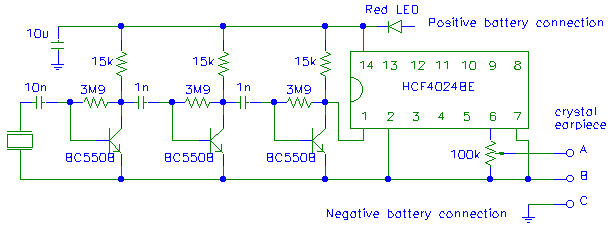Ultra-simple division bat detector [unfinished!]
I have been thinking about an even simpler frequency division bat detector with super-low power consumption, consisting of a few transistors that perform pre-amplification, a 4024 CMOS for frequency division and no end-amplifier. The current consumption is about 1 mA at 6V supply.The basic idea is shown below:
 The pre-amplifier consists of three essentially identical transistor stages.
They are biased for a current of about 0.2 mA and an output collector voltage of 3V, giving
a gain of 70 each.
Biasing in this circuit relies on the value of hfe to be about 250, which means that the choice
of transistor is important.
On the other hand, this biasing scheme requires only a relatively small number of components.
The pre-amplifier consists of three essentially identical transistor stages.
They are biased for a current of about 0.2 mA and an output collector voltage of 3V, giving
a gain of 70 each.
Biasing in this circuit relies on the value of hfe to be about 250, which means that the choice
of transistor is important.
On the other hand, this biasing scheme requires only a relatively small number of components.The capacitors between the transistor stages give the pre-amplifier a high-pass characteristic to reduce the influence of audible sounds, although this is not a great problem with piezo transducers. The 100pF capacitor at the last stage limits the bandwidth to about 100 kHz to reduce noise. It is perhaps better to place this capacitor across the collector of the middle transistor, where the signal is more linear.
The signal coming out of the pre-amplifier is biased at exactly half the supply voltage by the two 150k resistors and then fed into the schmitt-trigger input of the 4024 CMOS IC. From pin 6, the divide-by-16 output is taken to a crystal earpiece.
The crystal earpiece can be driven without any additional end-amplifier, saving in current consumption (a single LM386 already consumes about 4 mA when idling!).
Some improvements to this idea are:
- Adjustable detection treshold by replacing the 15k resistor connected to the middle
transistor by a potentiometer.
A 10k pot will work. - More effective low-pass filtering by adding capacitors across the collectors of the other two transistors.
- A low-pass filter at the output to reduce the high order harmonics of the output square wave. Also a combination of an output coupling capacitor to the crystal earpiece and a high-value resistor across the earpiece would reduce the earpiece DC voltage.
- A volume control for the output to the earpiece.
This can be easily done by connecting a 100k pot to the output and connecting the earpiece to the wiper of the potmeter. - A clever wiring scheme that energises the circuit when the earpiece is plugged in, obviating the need for a power switch, as shown on the pages of Tony Messina.
- A means of keeping the supply voltage constant. Because the total gain depends strongly on the supply voltage, a variation in the supply voltage would a strong variation in gain.
 Continuing on that last point, constant supply voltage, I found a simple circuit to regulate
the supply voltage.
It is shown on the right.
Continuing on that last point, constant supply voltage, I found a simple circuit to regulate
the supply voltage.
It is shown on the right.The lower transistor senses the output voltage and drives the upper transistor to keep the voltage at the lower transistor's base equal to about 0.55V. In this case, it will result in an output voltage of about 6V, relatively independent of the input voltage.
I have also considered a 7806 regulator, but these regulators consume more current than the circuit itself does.
Another solution is to use a battery that keeps a constant voltage, like a rechargeable '9V battery' (actually 7.2V).
Using this simple regulator, the circuit seems to work pretty well. I have some problems with oscillations when the detector is in its most sensitive setting, but I expect that is partly because of stray capacitance on my breadboard.
Yet another simple circuit
Simplifying the circuit even further, I came up with the following design. (I think this is about as simple as it can get)
The current consumption for this circuit is very low at about 2 mA, 1 mA for the pre-amp and another 1 mA for the CMOS IC.
Inserting the crystal earphone plug into the detector switches the detector on. It should be wired such that the actual earphone is connected between points A and B. Points B and C should be connected when the plug is inserted. This method is given in more detail here.
This page was last updated Sunday, April 02, 2000